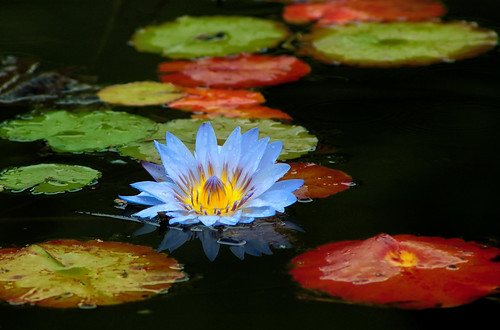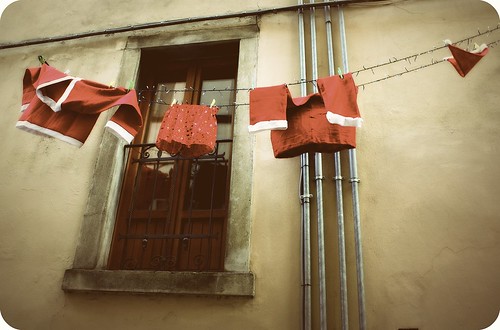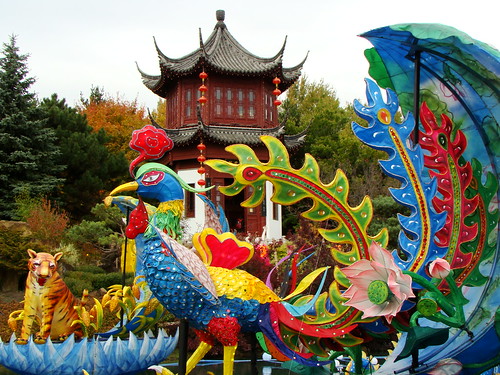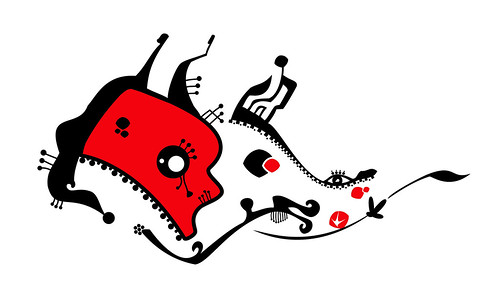Another gorgeous water lilly in Bordeaux. It was a rare intermission in non-stopping rain....
.
. .
. . .
. . . .
. . . . .
. . . . . .
. . . . .
. . . .
. . .
. .
.
lunes, diciembre 21, 2009
Ajudante de Papai Noel
Avatar Movie Trailer [HD]
Avatar is a 2009 American-British epic 3-D science fiction film written and directed by James Cameron, starring Sam Worthington, Zoë Saldaña, Sigourney Weaver and Stephen Lang. The film was produced by Lightstorm Entertainment and distributed by 20th Century Fox. It premiered in London on December 10, 2009, and was released in the United Kingdom on December 17, 2009, one day prior to its theatrical release in the United States.
The film focuses on an epic conflict on Pandora, an inhabited Earth-sized moon of Polyphemus, one of three fictional gas giants orbiting Alpha Centauri A. On Pandora, human colonists and the sapient humanoid indigenous inhabitants of Pandora, the Na'vi, engage in a war over the planet's resources and the latter's continued existence. The film's title refers to the remotely controlled, genetically engineered human-Na'vi bodies used by the film's human characters to interact with the natives.
Avatar had been in development since 1994 by Cameron, who wrote a 114-page scriptment for the film. Filming was supposed to take place after the completion of Titanic, and the film would have been released in 1999, but according to Cameron, "technology needed to catch up" with his vision of the film. In early 2006, Cameron developed the script, the language, and the culture of Pandora. He has stated that if Avatar is successful, two sequels to the film are planned.
The film was released in traditional 2D and 3D formats, along with an IMAX 3D release in selected theaters. Avatar is officially budgeted at $237 million; some estimates put the cost at $310 – $430 million to produce and an estimated $150 million for marketing, with a further $50 million buffer inserted to cover further costs. The film is being touted as a breakthrough in terms of filmmaking technology, for its development of 3D viewing and stereoscopic filmmaking with cameras that were specially designed for the film's production. Opening to critical acclaim, it earned an estimated $27 million on its opening day and an estimated $73 million domestically after three days. Worldwide, the film earned an estimated $232,180,000 in its opening weekend, the ninth largest opening-weekend gross of all time, and the largest for a non-franchise, non-sequel and original film.
Avatar is centered around the themes of imperialism and biodiversity. Cameron has said that Avatar shares themes with At Play in the Fields of the Lord, and The Emerald Forest, which feature clashes between cultures and civilizations, and acknowledged the film's connection with Dances With Wolves, where a battered soldier finds himself drawn to the tribal culture he was initially fighting against.
At Comic Con 2009, Cameron told attendees that he wanted to make "something that has this spoonful of sugar of all the action and the adventure and all that, which thrills me anyway as a fan, but also wanting to do something that has a conscience, that maybe in the enjoying of it makes you think a little bit about the way you interact with nature and your fellow man." He added that "the Na'vi represent something that is our higher selves, or our aspirational selves, what we would like to think we are," and "the humans in the film, even though there are some good ones salted in, represent what we know to be the parts of ourselves that are trashing our world and maybe condemning ourselves to a grim future."
In a 2007 interview with Time magazine, Cameron addressed the meaning of the film's title, answering the question "What is an avatar, anyway?" with "It's an incarnation of one of the Hindu Gods taking a flesh form. In this film what that means is that the human technology in the future is capable of injecting a human's intelligence into a remotely located body, a biological body. It's not an avatar in the sense of just existing as ones and zeroes in cyberspace. It's actually a physical body."
Pandora, the lush jungle planet with incredible life-forms and non-technological native population, is featuring prominently in several of the famous Russian Sci-Fi authors the Strugatsky brothers works, with one of them, the late 1960-s "Snail on the Slope", specifically featuring a downed human helicopter pilot whose severed head was fastened on a native's body; he becomes integrated into their society – having his conscience in effect implanted into an alien body – and becomes a warrior on their behalf in the end.
http://en.wikipedia.org/wiki/Avatar_%282009_film%29
http://en.wikipedia.org/wiki/James_Cameron
Avatar Movie Trailer [HD]
Alice In Wonderland - Official Trailer [HD]
Alice In Wonderland - Official Trailer [HD]
Alice in Wonderland is an upcoming 2010 fantasy adventure film directed by Tim Burton. It is an extension to the Lewis Carroll novels Alice's Adventures in Wonderland and Through the Looking-Glass. The film will use a technique combining live action and motion capture technology. Mia Wasikowska plays the role of Alice, alongside Johnny Depp as The Mad Hatter, Helena Bonham Carter as The Red Queen, Anne Hathaway as The White Queen, and Crispin Glover as The Knave of Hearts.
An extension on Lewis Carroll's original stories, Alice Kingsley, now 19, attends a party at a Victorian estate only to find she is about to be proposed to by a rich suitor in front of hundreds of snooty society types. She runs off, following a white rabbit into a hole and ending up in Wonderland, a place she visited many years before, yet she doesn't remember. The White Rabbit claims to have come back for Alice because she is the only one who can slay the Jabberwock, the beast who guards the Red Queen's empire. Alice remains completely unaware of why she is in Wonderland, and is confused about the fact that she had once visited Wonderland years before. She then embarks big and small on an adventure of self discovery and to save Wonderland from the Red Queen's reign of terror with the help of her Wonderland friends.
http://en.wikipedia.org/wiki/Alice_in_Wonderland_%282010_film%29
http://en.wikipedia.org/wiki/Tim_Burton
Alice In Wonderland - Official Trailer [HD]
miércoles, diciembre 16, 2009
Le vacanze di babbo natale
Ready to make a Merry Christmas :)
Happy
Hollidays !!!
Le vacanze di babbo natale
jueves, noviembre 19, 2009
Alejandro Jodorowsky - Tarot of Marseilles
Alejandro Jodorowsky - Tarot of Marseilles
miércoles, noviembre 18, 2009
Alejandro Jodorowsky
Jodorowsky began his artistic activities at a very young age, inspired greatly by film and literature. He began publishing his poetry in Chile when he was 16. At this time, he worked alongside the Chilean poets Nicanor Parra and Enrique Lihn. He developed an interest in puppetry and mime. He published his first book of poetry when he was 16. At 17, he debuted as an actor and a year later he created the pantomime troupe, Teatro Mímico. In 1953, Jodorowsky wrote his first play, El minotauro (The Minotaur). That same year he traveled to Paris to study pantomime with Etienne Decroux, the teacher of Marcel Marceau. The next year he joined Marcel Marceau theatre troupe; the performances realized during this collaboration toured worldwide. In 1955 he attended university in Santiago, Chile. After performing in Mexico in 1960, Jodorowsky decided to continue his stay in order to pursue other theatrical endeavors.
In February 1962, in Paris, Jodorowsky, along with Fernando Arrabal and Roland Topor, initiated the Panic Movement[1], an artistic movement centered around three basic elements: terror, humor, and simultaneity. These acts combine layers of physical postures inspired by the imagination and integrate artistic elements. Acts of this movement include Cuentos pánicos, Teatro pánico, Fabulas pánicas and Efímeros pánicos.
| Alejandro Jodorowsky | |
|---|---|
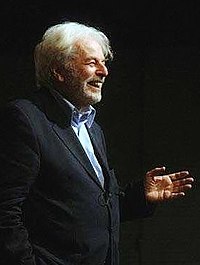 | |
| Born | February 7, 1929 (1929-02-07) (age 80) |
| Spouse(s) | Valerie Jodorowsky |
Throughout the 60s and 70s, working in Paris and Mexico, Jodorowsky created over one hundred theatrical productions. He directed works of his own in addition to those written by Leonora Carrington, Samuel Beckett, Eugen Ionesco, August Strindberg and others. El acto efímero (or "ephemeral performances") was acted out in public spaces, drawing attention to the quotidian while promoting critical awareness in both participants and audience. During these ephemeral acts the public is often unaware that an act of drama is being performed. Jodorowsky once stated: "the panic man is not, he is ever becoming" to reference Alfred Korzybski's influence on his thought.
Beginning in 1966, Jodorowsky created comics relating to "El pánico." These comics were made independently and in collaboration with illustrators including Jean "Mœbius" Giraud. In the course of his comic career, Jodorowsky has created approximately 21 series including Fábulas pánicas, Los ojos del gato and El incal. All translated from Spanish into over ten languages.
Jodorowsky's first experience with movies was in 1957 in Paris, where he adapted Thomas Mann’s Las cabezas trocadas as La Cravate. He next created Fando y Lis in Mexico in 1967[1]. Two years later, Jodorowsky created his most renowned film, El Topo (aka The Mole). In the following years additional films were realized including The Holy Mountain in 1972.
Jodorowsky spent over fifteen years reconstructing the original form of the Tarot de Marseille. From this work he moved in to more therapeutic work in three areas: psychomagic, psychogenealogy and initiatic massage. Psychomagic aims to heal psychological wounds suffered in life. This therapy is based on the belief that the performance of certain acts can directly act upon the unconscious mind, releasing it from a series of traumas, some of which are passed down from generation to generation. Psychogenealogy includes the studying of the patient’s personality and family tree in order to best address their specific sources.
Jodorowsky has several books on his therapeutic methods, including Psicomagia: La trampa sagrada (Psychomagic: The Sacred Trap) and his autobiography La danza de la realidad (The Dance of Reality). To date he has published over 23 novels and philosophical treaties, along with dozens of articles and interviews. His books are widely read in Spanish and French, but are for the most part unknown to English-speaking audiences.
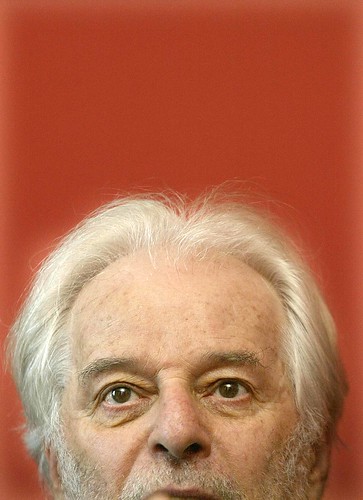
Alejandro Jodorowsky, inserito originariamente da bernacordon.
Throughout his career, Jodorowsky has gained a reputation as a philosopher and scholar who presents the teachings of religion, psychology and spiritual masters, by molding them into pragmatic and imaginative endeavors. All of his enterprises integrate an artistic approach. Currently Jodorowsky dedicates much of his time to lecturing about his work.
For a quarter of a century, Jodorowsky held classes and lectures for free, in cafés and universities all over the city of Paris. Typically, such courses or talks would begin on Wednesday evenings as tarot divination lessons, and would culminate in an hour long conference, also free, where at times hundreds of attendees would be treated to live demonstrations of a psychological "arbre généalogique" ("tree of genealogy") involving volunteers from the audience. In these conferences, Jodorowsky would pave the way to building a strong base of students of his philosophy, which deals with understanding the unconscious as the "over-self" which is comprised of many generations of family relatives, living or deceased, acting on our own psyche, well into our adult lives, and causing our compulsions. It is important to note that of all his work, Jodorowsky considers these activities to be the most important of his life. Though such activities only take place in the insular world of Parisian cafés, he has devoted thousands of hours of his life to teaching and helping people "become more conscious," as he puts it.
Presently, these talks have dwindled to once a month and take place at the "Librairie Les Cent Ciels" in Paris.
http://en.wikipedia.org/wiki/Alejandro_Jodorowsky
Alejandro Jodorowsky
Jodorowsky

Dona Magdalena: taught him initiatic/spiritual massage
La Tigresa: a famous Mexican Actress
Reyna D'Assia: the daughter of G.I. Gurdjieff, a spiritual leader
Maria Sabina: priestess of the sacred mushrooms
Pachita: a mystical healer
Violeta Parra: Chilean Singer
He started his film career in Mexico with Fando y Lis (1968). The feature-length film debuted in Acapulco at the Film Festival and is famous for having incited a full scale riot there, requiring that Jodorowsky be smuggled out in a limousine.
El Topo (1970), a mystical Western, was his second film and is now considered a cult classic. John Lennon and Yoko Ono helped to arrange the film's release and distribution in the United States through Beatles manager Allen Klein. It tells the story of El Topo, a Mexican gunslinger, in three main story arcs: (1) his revenge on a gang of bandits for their massacre of a small town's entire population; (2) his love for a woman, the woman's demands that El Topo take on four master gunmen who live in the desert, and El Topo's resulting fall from grace; and (3) El Topo's reawakening several years later in a colony of deformed people, his endeavor to release them from a mountain cave in which they are trapped, and his atonement.
Jodorowsky's third film, The Holy Mountain (La montaña sagrada) (1973), was entirely financed by John Lennon and Yoko Ono through the production office of Beatles producer Allen Klein. It has been suggested that The Holy Mountain may have been inspired by Rene Daumal's surrealist novel Mount Analogue. The Holy Mountain was another complex, multi-part story that featured a man credited as "The Thief" and equated with Jesus Christ, a mystical alchemist played by Jodorowsky, seven powerful business people representing seven of the planets (Venus and the six planets from Mars to Pluto), a religious training regimen of spiritual rebirth, and a quest to the top of a holy mountain for the secret of immortality. During the completion of The Holy Mountain, Jodorowsky received spiritual training from Oscar Ichazo of the Arica School, who encouraged him to take LSD and guided him through the subsequent psychedelic experience. Around the same time (2 November 1973), Jodorowsky participated in an isolation tank experiment conducted by John Lilly.
Shortly thereafter, Allen Klein demanded that Jodorowsky create a film adaptation of The Story of O, an erotic novel heavy on BDSM. Klein had promised this adaptation to various investors. Jodorowsky, who had discovered feminism during the filming of The Holy Mountain, refused to make the film, going so far as to leave the country to escape directing duties. In retaliation, Allen Klein made El Topo and The Holy Mountain, to which he held the rights, completely unavailable to the public for over 30 years. Jodorowsky frequently decried Klein's actions in interviews.
In December 1974, a French consortium led by Jean-Paul Gibon purchased the film rights to Dune from Arthur P. Jacobs. Jodorowsky was set to direct. In 1975, Jodorowsky planned to film the story as a ten hour feature, in collaboration with Salvador Dali, Orson Welles, Gloria Swanson, David Carradine, Geraldine Chaplin, Alain Delon, Hervé Villechaize and Mick Jagger. The music would be composed by Peter Gabriel. Jodorowsky set up a pre-production unit in Paris consisting of Chris Foss, a British artist who designed covers for science fiction periodicals, Jean Giraud (Moebius), a French illustrator who created and also wrote and drew for Metal Hurlant magazine, and H. R. Giger. Moebius began designing creatures and characters for the film, while Foss was brought in to design the film's space ships and hardware. Giger began designing the Harkonnen Castle based on Moebius' storyboards, and Dali was cast as the Emperor with a reported salary of $100,000 an hour. His son Brontis Jodorowsky was to play Paul. Dan O'Bannon was to head the special effects department.
Dali and Jodorowsky began quarreling over money, and just as the storyboards, designs, and script were finished, the financial backing dried up. Frank Herbert travelled to Europe in 1976 to find that $2 million of the $9.5 million budget had already been spent in pre-production, and that Jodorowsky's script would result in a 14-hour movie ("It was the size of a phonebook", Herbert later recalled). Jodorowsky took creative liberties with the source material, but Herbert said that he and Jodorowsky had an amicable relationship.
The rights for filming were sold once more, this time to Dino de Laurentiis. Although Jodorowsky was embittered by the experience, he stated that the Dune project changed his life.
After the collapse of the Dune project, Jodorowsky completely changed course and, in 1980, premiered his children's fable "Tusk", shot in India. Taken from Reginald Campbell's novel "Poo Lorn of the Elephants," the film explores the soul-mate relationship between a young British woman living in India and a highly prized elephant. The film exhibited little of the director's outlandish visual style and was never given wide release. Jodorowsky has since disowned the film.
In 1989, Jodorowsky completed Mexican-Italian production Santa sangre (Holy Blood). The film received limited theatrical distribution, putting Jodorowsky back on the cultural map despite its mixed critical reviews. Santa Sangre was a surrealist film with a plot similar to Alfred Hitchcock's Psycho. It featured a protagonist who, as a child, saw his mother lose both her arms, and as an adult let his own arms act as hers, and so was forced to commit murders at her whim. Several of Jodorowsky's sons were recruited as actors.
He followed in 1990 with a very different film, The Rainbow Thief. Though it gave Jodorowsky a chance to work with actual "movie stars" Peter O'Toole and Omar Sharif, the producer effectively curtailed most of Jodorowsky's artistic inclinations, threatening to fire him on the spot if anything in the script was changed.
In the 1990s and early 2000s, Jodorowsky attempted to make a sequel to El Topo, called at different times The Sons of El Topo and Abelcain, but could not find investors for the project.
In 2000, Jodorowsky won the Jack Smith Lifetime Achievement Award from the Chicago Underground Film Festival (CUFF). He attended the festival and his films were shown, including El Topo and The Holy Mountain, which at the time had grey legal status. According to festival director Bryan Wendorf, it was an open question of whether CUFF would be allowed to show both films, or whether the police would show up and shut the festival down.

jodorowsky, inserito originariamente da pompier.
Until 2007, Fando y Lis and Santa sangre were the only Jodorowsky's works available on DVD. Neither El Topo nor The Holy Mountain were available on videocassette or DVD in the United States or the United Kingdom, due to ownership disputes with distributor Allen Klein. After the dispute's settlement in 2004, however, plans to re-release Jodorowsky's films were announced by ABKCO Films. On January 19, 2007, the website announced that on May 1, 2007, Anchor Bay released a box set including El Topo, The Holy Mountain, and Fando y Lis. A limited edition of the set includes both the El Topo and The Holy Mountain soundtracks. And, in early February 2007, Tartan Video announced its May 14, 2007, release date for the UK PAL DVD editions of El Topo, The Holy Mountain and the 6-disc box set which, alongside with the aforementioned feature films, includes the 2 soundtrack CDs, as well as separate DVD editions of Jodorowsky's 1968 debut feature Fando y Lis (with his 1957 short La cravate aka Les têtes interverties, included as an extra) and the 1994 feature-length documentary La constellation Jodorowsky. Notably, Fando y Lis and La cravate were extensively digitally restored and remastered in London during late 2006, thus providing the perfect complement to the quality restoration work undertaken on El Topo and The Holy Mountain in the States by Abkco, and ensuring that the presentation of Fando y Lis is a significant improvement over the 2001 Fantoma DVD edition. Prior to the availability of these legitimate releases, only inferior quality, optically censored bootleg copies of both El Topo and The Holy Mountain have been circulated on the Internet and on DVD.
In an interview with Premiere Magazine, Jodorowsky said his next project will be a gangster film called King Shot. Marilyn Manson will play a 300-year-old pope, he said, and Nick Nolte has also expressed interest in working with the director. Both are also listed as executive producers for the film, which has a projected release date of 2009 . David Lynch is also rumored to be a producer. In the interview, Jodorowsky also said he wanted to make a sequel to El Topo, but couldn't raise the funds. In a recent interview by Viceland, he also indicated that financing for King Shot was proving to be difficult.
In an interview with The Guardian newspaper in November 2009, Jodorowsky revealed that he was unable to find the funds to make King Shot, and would instead be entering preparations on Son of El Topo, for which he claimed to have signed a contract with "some Russian producers".
The book Anarchy and Alchemy: The Films of Alejandro Jodorowsky is the first major English language study on the cinema of Jodorowsky.
Jodorowsky started his comic career in Mexico with the creation of Anibal 5 series in the mid 1966 with illustrations by Manuel Moro, and had his turn in drawing his own comic strip in the weekly series Fabulas pánicas that appeared in the Mexican newspaper El Heraldo de México. He also wrote original stories for at least two or three other comic books in Mexico during those days: Los insoportables Borbolla was one of them. After his fourth film, Tusk, he started The Incal, with Jean Giraud (Mœbius). This graphic novel has its roots deep in the tarot and its symbols, e.g., the protagonist of The Incal, John Difool, is linked to the Fool card. The Incal (which would branch off into a prequel and sequel) forms the first in a sequence of several science fiction comic book series, all set in the same space opera Jodoverse (or "Metabarons Universe") published by Humanoids Publishing.
Comic books set in this milieu are Incal (trilogy: Before the Incal/ Incal/ After the Incal), Metabarons (trilogy: Dayal de Castaka/ The Caste of the Metabarons/ The Dreamshifters) and The Technopriests and also a RPG adaptation, The Metabarons Roleplaying Game. Many ideas and concepts derived from Jodorowsky's planned adaptation of Dune (which he would have only loosely based upon Frank Herbert's original novel) are featured in this universe.
Mœbius and Jodorowsky sued Luc Besson, director of The Fifth Element, claiming that the 1997 film borrowed graphic and story elements from The Incal, but lost their case. The suit was plagued by ambiguity since Mœbius himself had willingly participated in the creation of the film, having been hired by Besson as a contributing artist, but had done so without gaining the approval of Incal co-creator Jodorowsky, whose services Besson did not call upon. For over a decade, Jodorowsky pressured his publisher Les Humanoïdes Associés to sue Luc Besson for the flagrant act of plagiarism, but the said publisher refused, rightfully fearing the inevitability of the final outcome. In a 2002 interview with the Danish comic book magazine Strip!, Jodorowsky actually claimed that he considered it an honour that somebody stole his ideas, which is not surprising, as Jodorowsky believes that authors do not create the stories they tell as much as they make personal interpretations of myths universal to the collective human subconsciousness. Privately, however, Jodorowsky has used harsh words in his retelling of how the plagiarizing of the Incal was supported by the courts, and often deplored the bias typically shown by French courts toward large industrial entities, to the detriment of comic book artists and writers. He has expressed great comfort, however, at the fact that anyone actually familiar with his creation has agreed that the work was obviously plagiarized by Besson.
Other action comics by Jodorowsky outside the genre of science fiction include the historically-based Bouncer illustrated by Francois Boucq, Juan Solo (Son of the Gun) and Le Lama blanc (The White Lama), both illustrated by Georges Bess.
Le Cœur couronné (The Crowned Heart, translated into English as The Madwoman of the Sacred Heart), a racy satire on religion set in contemporary times, won Jodorowsky and his collaborator, Jean Giraud, the 2001 Haxtur Award for Best Long Strip. He is currently working on a new graphic novel for the US market.
Jodorowsky's comic book work also appears in Taboo volume 4 (ed. Stephen Thrower), which features an interview with the director, designs for his version of Frank Herbert's Dune, comic storyboards for El Topo, and a collaboration with Moebius with the illustrated Eyes of the Cat.
He collaborated with Milo Manara in Borgia (2006), a graphic novel about the history of the House of Borgia.
http://www.clubcultura.com/clubliteratura/clubescritores/jodorowsky/index.htm
http://en.wikipedia.org/wiki/Alejandro_Jodorowsky
Jodorowsky
viernes, noviembre 06, 2009
The art of Light on Water- Chinese Lanternes de Chine
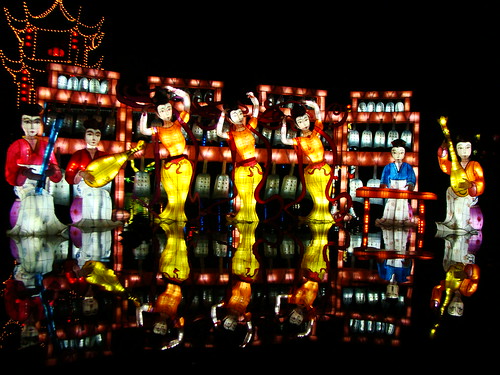
The art of Light on Water- Chinese Lanternes de Chine , inserito originariamente da herberouge1 somewhere over the rainbow.
The art of Light on Water- Chinese Lanternes de Chine
The art of Light on Water- Chinese Lanternes de Chine
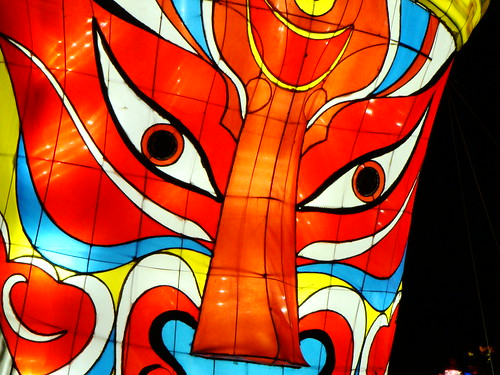
The art of Light on Water- Chinese Lanternes de Chine , inserito originariamente da herberouge1 somewhere over the rainbow.
The art of Light on Water- Chinese Lanternes de Chine
Sumidero Canyon - Cañón del Sumidero

This canyon is a result of a geological fault during the Pleistocene. The canyon is regarded as an important tourist attraction in the state of Chiapas. The importance and cultural symbolism of Sumidero Canyon for Chiapans are so great that its silhouette is the base of the Coat of Arms of the state of Chiapas.
The Sumidero Canyon is home to a great variety of wildlife including crocodiles.
El Cañón del Sumidero, es un orificio de gran profundidad situado a 5 km de Tuxtla Gutiérrez, capital del estado de Chiapas, México. Este cañón tiene un acantilado cuya altura va un poco más allá de los 1000 m del nivel del agua y se levanta sobre el cauce del río Grijalva, que tiene una profundidad de más de 300 m.
Río que atraviesa los estados de Chiapas y Tabasco y desemboca en el Golfo de México. En su boca sur, el cañón inicia en Chiapa de Corzo, y desemboca en el embalse artificial de la presa hidroeléctrica Manuel Moreno Torres, mejor conocida popularmente como "Chicoasén".
La relevancia del cañón del sumidero es tal que forma parte del Escudo de Chiapas.
Por su singular belleza y su importancia histórica, el ícono de Chiapas está nominado para una de las "Nuevas 7 Maravillas Naturales" como único representante de México en este concurso internacional.
La manera más habitual de llegar es en automóvil, autobús o pagando un recorrido guiado que puede incluir un recorrido en lancha y al ecoturístico que esta frente a la presa chicoasen. Se toma la carretera de Tuxtla Gutiérrez hasta los miradores del Cañón. También en el Museo de Antropología puede abordar un colectivo que lo lleve al mirador Los Chiapa. Si desea puede visitar el Parque Zoológico Miguel Álvarez del Toro (ZOOMAT), que le queda en el camino.
Otra alternativa es llegar en lancha, puede zarpar desde Cahuaré o Chiapa de Corzo.
Este cañón es producto de una separación de capas terrestres producto de una falla geológica durante el pleistoceno. Por sus dimensiones y vegetación tropical exuberante, este cañón es un importante atractivo turístico del estado de Chiapas.
Durante la conquista española de la región, la etnia Chiapa (o soctona, en su propio idioma) realizó un suicidio masivo al arrojarse desde la cumbre hacia el fondo del cañón para evitar quedar sometidos al conquistador -con ello creían, además, alcanzar la libertad en el inframundo. La importancia y simbolismo cultural de este cañón para los chiapanecos son tan grandes que su silueta es la base del escudo de armas del estado de Chiapas
http://en.wikipedia.org/wiki/Tuxtla_Guti%C3%A9rrez
http://en.wikipedia.org/wiki/Ca%C3%B1%C3%B3n_del_Sumidero
http://www.turismochiapas.gob.mx/canonsumidero.html
http://www.mapasmexico.net/googlemaps-canon-sumidero.html
Sumidero Canyon - Cañón del Sumidero
miércoles, octubre 28, 2009
Clouded Leopard

The average Clouded Leopard typically weighs between 15 and 23 kg (33 to 50 lb) and has a shoulder height of 25 to 40 centimeters (10 to 16 inches). This medium sized cat has a large build and, proportionately, the longest canine teeth (2 in, about the same as a tiger's) of any living feline. These characteristics led early researchers to speculate that it preyed on large land-dwelling mammals. However, while remarkably little is known about the natural history and behavioral habits of this species in the wild, it is now thought that its primary prey includes arboreal and terrestrial mammals, particularly gibbons, macaques, and civets supplemented by other small mammals, deer, birds, porcupines, and domestic livestock. Clouded Leopards that are held in captivity also eat eggs and some vegetation.
As might be expected from the fact that some of its prey lives in trees, the Clouded Leopard is an excellent climber. Short, flexible legs, large paws, and sharp claws combine to make it very sure-footed in the canopy. The Clouded Leopard's tail can be as long as its body, further aiding in balance giving it a squirrel-like agility similar to the Margay of South America. Surprisingly, this arboreal creature can climb while hanging upside-down under branches and descend tree trunks head-first. In captivity, the Clouded Leopard routinely hangs by its hind legs using its long tail for balance and runs head-first down tree trunks. Little is known about its behaviour in the wild, but it is assumed from this behavior that a favored hunting tactic is to drop on prey from the trees.
The Clouded Leopard, despite its name, is not closely related to the Leopard. The Clouded Leopard is regarded as having three subspecies:
- Neofelis nebulosa macrosceloides: Nepal to Myanmar (Burma)
- Neofelis nebulosa nebulosa: Southern China to eastern Myanmar
- Neofelis nebulosa brachyura: Taiwan (extinct)
The Bornean Clouded Leopard (Neofelis diardi) is a separate species found on Sumatra, Borneo and the Batu Islands. Because of their distinct skull structure, the two species are considered sufficiently different to be the only members of their genus.
The Clouded Leopard is found only in Southeast Asia and ranges through southern China (at least as far north as Wuyi Shan), the eastern Himalayas, Nepal, northeast India, Bangladesh, and Indochina. It is thought to be extinct in Taiwan. The last confirmed sighting of a Clouded Leopard in Taiwan was in 1989 when the skin from a small leopard was found in the Taroko area. This subspecies was characterized by its relatively much shorter tail.
Preferred habitat is tropical and subtropical forests at altitudes up to about 2,000 meters (6,500 ft); however it is sometimes found in mangrove swamps and grassland. It lives in temperatures from 65 to 120 degrees Fahrenheit.
The behaviour of the Clouded Leopard in the wild is virtually unknown to man because of the animal's reclusive nature. With no evidence for a pack- or pride-society like that of the lion, it is assumed that it is a generally solitary creature.
Females give birth to a litter of 2 to 4 cubs after a gestation period of about 85 to 93 days. Initially, the young are blind and helpless, much like the young of many other cats. Unlike adults, the kittens' spots are "solid"—completely dark rather than dark rings. The young can see within about 10 days of birth, are active within 5 weeks, and probably become independent at about 10 months of age. The Clouded Leopard reaches sexual maturity at two years of age and females are able to bear one litter each year. Adults in captivity have lived as long as 17 years: in the wild, they have an average 11 year lifespan.
Captive breeding programs met with little success in their early stages, largely due to ignorance of courtship activity among these cats in the wild. Experience has taught keepers that introducing pairs of Clouded Leopards at a young age gives opportunities for the pair to bond and breed successfully. Introducing pairs as older adults may cause the animals such stress that the male may kill the female. Normally, the Clouded Leopard is not an aggressive animal.
Modern breeding programs involve carefully regulated introductions between prospective mating pairs and take into account the requirements for enriched enclosures. Providing these animal with adequate space to permit climbing stimulates natural behaviour and minimizes stress. This, combined with a feeding programme that fulfills the proper dietary requirements, has promoted more successful breeding in recent years. Cats born in captivity may one day supplement threatened populations in the wild.
Because the Clouded Leopard's habits make it difficult to study, reliable estimates of its population do not exist. The World Conservation Union estimates that fewer than 10,000 individuals exist, and warns that the population is declining. Habitat loss due to widespread deforestation and hunting for use in Chinese medicinal preparations are thought to be causing populations of the Clouded Leopard to decline. Only six Clouded Leopards have ever been radio collared and their territorial movements monitored and recorded by scientists using radio telemetry. All of these cats were studied within Thailand. Almost all that is known of the Clouded Leopard today comes from studies of the cats in captivity. Apart from anecdotal accounts very little is known of the Clouded Leopard's natural history, ecology and behaviour in the wild throughout its range.
The World Conservation Union, the organization that maintains the global Red List of endangered species, lists the Clouded Leopard as Vulnerable. In addition, CITES, the Convention on International Trade in Endangered Species of Wild Fauna and Flora, lists the Clouded Leopard as an Appendix I species, meaning that international trade in Clouded Leopards is banned. The United States also lists the Clouded Leopard under the Endangered Species Act, further prohibiting trade in the animals or any parts or products made from them in the United States. In the countries of its native range, hunting of the Clouded Leopard is prohibited; however, these bans are poorly enforced.
http://en.wikipedia.org/wiki/Clouded_Leopard
http://susty.com/clouded-leopard-neofelis-nebulosa-species-spotlight/
Clouded Leopard
lunes, octubre 26, 2009
viernes, octubre 23, 2009
Whale - ship - Merkabah
Whale - ship - Merkabah
lunes, octubre 05, 2009
In memoriam, Mercedes Sosa, Managua, 1983
Sosa was born on July 9, 1935, in San Miguel de Tucumán, in the northwestern Argentine province of Tucumán, of mestizo, French, andQuechua Amerindian ancestry. In 1950, at age fifteen, she won a singing competition organized by a local radio station and was given a contract to perform for two months. She recorded her first album, La Voz de la Zafra, in 1959. A performance at the National Folklore Festival brought her to the attention of her native countrypeople.
Sosa and her first husband, Manuel Óscar Matus, with whom she had one son, were key players in the mid-60s nueva canción movement (which was called nuevo cancionero in Argentina). Her first record was Canciones con Fundamento, a collection of Argentine folk songs.
In 1967, Sosa toured the United States and Europe with great success. In later years, she performed and recorded extensively, broadening her repertoire to include material from throughout Latin America.
In memoriam, Mercedes Sosa, Managua, 1983



